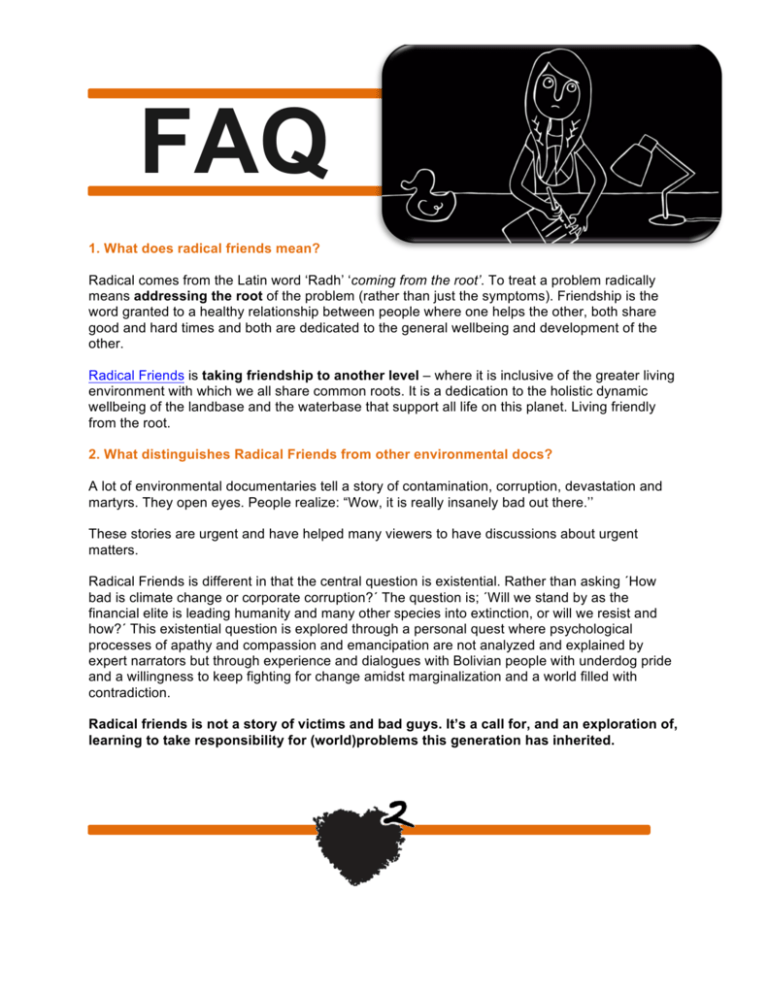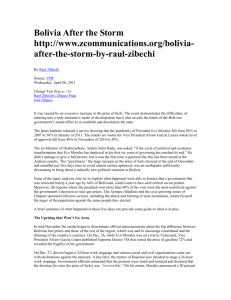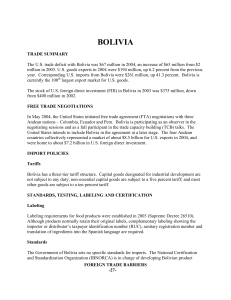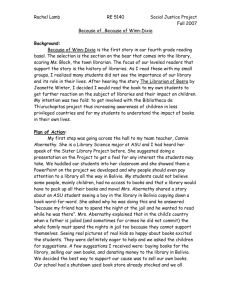1. What does radical friends mean? Radical comes from the Latin
advertisement

FAQ 1. What does radical friends mean? Radical comes from the Latin word ‘Radh’ ‘coming from the root’. To treat a problem radically means addressing the root of the problem (rather than just the symptoms). Friendship is the word granted to a healthy relationship between people where one helps the other, both share good and hard times and both are dedicated to the general wellbeing and development of the other. Radical Friends is taking friendship to another level – where it is inclusive of the greater living environment with which we all share common roots. It is a dedication to the holistic dynamic wellbeing of the landbase and the waterbase that support all life on this planet. Living friendly from the root. 2. What distinguishes Radical Friends from other environmental docs? A lot of environmental documentaries tell a story of contamination, corruption, devastation and martyrs. They open eyes. People realize: “Wow, it is really insanely bad out there.’’ These stories are urgent and have helped many viewers to have discussions about urgent matters. Radical Friends is different in that the central question is existential. Rather than asking ´How bad is climate change or corporate corruption?´ The question is; ´Will we stand by as the financial elite is leading humanity and many other species into extinction, or will we resist and how?´ This existential question is explored through a personal quest where psychological processes of apathy and compassion and emancipation are not analyzed and explained by expert narrators but through experience and dialogues with Bolivian people with underdog pride and a willingness to keep fighting for change amidst marginalization and a world filled with contradiction. Radical friends is not a story of victims and bad guys. It’s a call for, and an exploration of, learning to take responsibility for (world)problems this generation has inherited. 3. What is so special about Bolivia? Bolivia voices & defends the following; 1) In order to achieve environmental justice and ecological harmony ´legal rights for Mother Earth’ – mountains, rivers, forests – need to be recognized globally - read declaration or watch video. 2) To realize environmental healing, after the severe damage that has been done by industrial civilization, nation states have to use the global military budget for saving lives, species, habitat instead of destroying it. 3) Climate change, environmental justice and the general degradation of the waterbase and the landbase on which all life on earth depends, is a matter that concerns all of us and should not be discussed and agreed upon by a political or financial elite behind closed doors. In a democratic world the strategies and policies put in place for the survival of our species needs to be discussed in a world referendum. 4) The current politics of making a market for pollution (carbon market) is a false solution that does not stop pollution, it just another way of making money and creating privileges for the rich and denying the poor. 5) A concrete and urgent proposal for global reforestation project. 6) Industrialized countries (the developed countries) have an ecological debt they need to pay under the convention for contributing in a disproportionate percentage to the problem of wrecking ecosystems and causing environmental disasters. For more info check out this site or watch the former UN representative of Bolivia explain Bolivia´s position. 4. What do 'legal rights for Mother Earth' mean? It means that on a planet which is not only populated by humans, other species and living systems should not be denied their right to (co)exist and their right to health (live free of pollution) and when abused, the perpetrator is accountable in law. It means that humanity is ready to stop being blinded by narcissism and starts recognizing the rights of living communities we share this planet with. It means CEO´s of ultra big companies like Nestle, ADM, Cargill, Unilever, Monsanto and ofcourse the oil giants all face trial for the atrocities they have committed against the natural world. 5. What was it like meeting president Evo Morales? When people ask me what it was like meeting the president I never know what to say. I wanted a personal chat. And while Evo Morales has got to be one of the most approachable and easy to get to presidents in the world – the context of meeting the Bolivian president was a press conference. It was formal and restricted to a brief interaction. And while the five other people who got to ask a question were Bolivian journalists concerned with local affairs, I was sitting there nervously with a super personal question ´Is there still a message of hope, of struggle, from Bolivia for activists in the world who feel gutted after the UN Climate Summit (COP16) in Mexico where all perverse self-serving business giants got their wishes granted in a imposed agreement that was not addressing environmental needs but commercial interests?´ I don´t know how I thought any person, not even Evo Morales could answer that question. But he was my go-to guy when it came to articulation of a brave hopeful discourse. The whole journey through Bolivia taught me not to look for emancipation in others but to relate to other inspiring underdogs in order to trigger and elaborate on my own path of emancipation: self emancipation after all can not be given by an external party. 6. What was it like working with your own father? I knew it would be therapeutic working with my father I had never had a relationship with up until that point. We had only met 4 times before in Paris where he lives. These visits had all been my initiative and it required me-learning-his-language-from-scratch; Spanish. The rest of the cast are in some way deeply committed to environmental healing. My father represents the other side; The majority of people in society who mean no harm but don´t feel it is up to them to make a difference and get their hands dirty. Exploring this relationship was emotional but it helped me explore the voice of externalizing responsibility. I never meant to ´use´ him, i wanted a real living relationship that could undergo some sort of transformation from disconnection to connection. The awkward scene of the father-daughter fight works so well because the relationship with the camera man was so strong I trusted him completely and I really stopped being the director and was just that girl, scared and angry, sitting in front of her father asking him why he didnt care about her wellbeing and future. Final note: while the movie only shows small signs of reconciliation in real life the biggest catharsis came when we held our crew sneak preview screening in a cinema in Amsterdam. To my surprise Guillermo (father) came to Amsterdam; this was the first time he visited me in 16 years, the second time of my life - if you don’t count the moments when I was still a baby. The screening was a big success and we had a great talk afterwards. I think it was the first moment he really got what I was trying to say. The fact that he supported the film and even bought a couple of DVD´s really felt like the first step to intimacy. 7. As this is the first feature doc you directed, produced and played a part in; what did it take to get it done? 1: I Produced a movie with my own money (15.000 personal investment and almost 5.000 personal investment of the co producer). It gives creative freedom, but also increased stress. The project really depends on relationship: Do people like you and your project enough to contribute their expertise, work, equipment for free or practically free? The first year I had savings, which I spent on production. The second year was hard and I was working a side job part time but I didn’t make enough money to pay my monthly bills, let alone invest in the movie. By the time I finished the movie I had become so creative in getting by I flew out for a promotion tour without any budget. I couchsurfed for months and sold my long hair so I could eat. 2: I had to learn to take initiative all the time while being patient and flexible with the outcome. 3: Dig deeper and deeper in the story so the honesty of the project and myself could attract people working in TV and or film for a long time, people who were hungry to contribute to something meaningful. If you don’t have money to offer, you and your project really have to create value to attract people with more professional experience than yourself. Thanks to the cameraman, editor, animator and the sound correction the movie became cinema worthy. 8. How did you find your cast and crew? The answer might surprise you but I feel that I owe a lot to my Buddhist practice. Through chanting for certain people they appeared into my life. Facebook also played a part. Finding the camera man I owe thanks to Gabriela Telleria, a friend who put me in touch with her cousin who is DOP, who connected my to Freddy Delgado. All of this happened while already in Bolivia on the job. I really dived into production head first and then looked around me who were attracted to what I was trying to make I did not know co producer (Juan Morales), the animator (Marijn Herder), the sound designer (Peter Stoel) aswell as the people from Deepeei Film Production (the producers that lend me their camera set, mics and tripod) when I started production. As for cast I looked for people who were both inspiring, articulate, in the field of (direct) action or campaigning and whose humanity I could show. I was not interested in expert talking heads. I wanted dialogues. I didn’t want heroes. I wanted humans struggling with real life. When the audience laughs when Marcelo’s cellphone rings and he picks it up in the middle of an interview, it is not because it is funny, it is because it is showing his humanity and it is recognizable. I wanted people to be inspired by the filmed encounters without a pretense of false admiration. I wanted intimacy in all the encounters. The encounter with my dad is a stark contrast, which opens with wide shots. Slowly we move to medium wide and medium shots. But the distance and separation is tangible on all levels. 9. Who did you make this movie for? This movie is aimed for the disenfranchised and the wanna-be world fixers out there. But also for spiritual seekers who want to let go of learned helplessness and are looking for a path of emancipation. I made it for the people who, whether they want to or not, inherited a world in distress that is violated on the material and ideological sphere. I made it for the trees, mountains and rivers who have endured and who want to live in peace. 10. What do you hope this movie will achieve? The first reaction I wish to accomplish in the audience is that it raises questions; both about the world as about how they relate to it. The second effect I hope for is that people will dedicate themselves with more courage to healing themselves and their greater community! Both by taking new environmental friendly initiatives as well as tearing down the old infrastructure that is causing so much harm right now. I believe united in radical friendship – celebrating our diversity and a profound respect for all (nonhuman) life – we have the right bases to take action on the social level and fix our societies of mass destruction.









